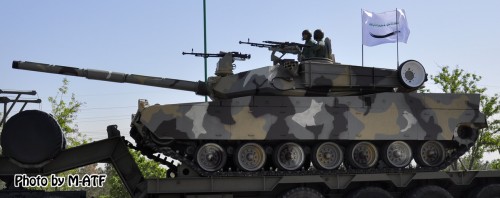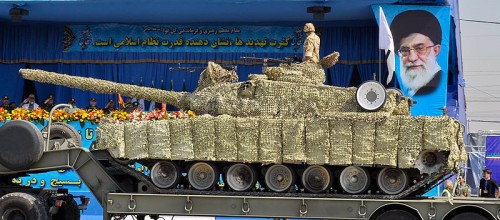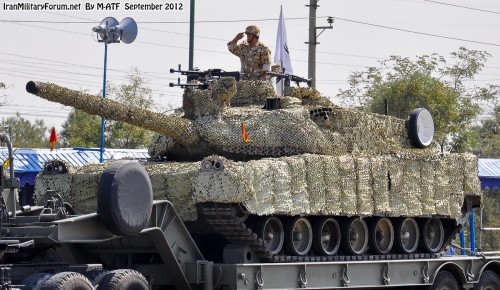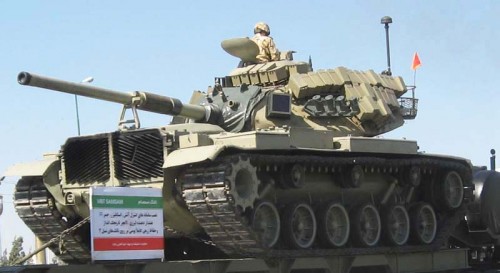Iranul va dezvalui doua modele de tancuri upgradate la nivel local!!!


Zolfaqar, profil
Iranul va prezenta publicului doua versiuni de tancuri actualizate de industria proprie.
Zolfaqar și Samsam vor fi expuse luni, cu ocazia aniversarii Revolutiei Islamice din 1979. Printre participantii la eveniment se anunta comandantul armatei, generalul de brigadă Ahmad Reza Pourdastan si alti oficiali de nivel inalt.
La 15 ianuarie Pourdastan a declarat ca noul model Zolfaqar a capatat o serie de imbunatatiri, in special sistemul de control si foc. Dupa prezentare, tancul va intra in productia de serie.

Tot Zolfaqar, de aceasta data din profil-fata
Zolfaqar este operat de un echipaj format din 3 soldati, arma principala este un tun 2A46, calibru 125mm, arme secundare 2 mitraliere 7,62mm si 12,7mm.

Samsam asta cu nume chinez
Samsam este o versiune de tanc M-60A1, modernizat de iranieni pentru a corespunde noilor cerinte pe campul de lupta.
Sursa: PressTV
NeroFlash





daca foloseste motor de elicoper ca Abramsu ,duplicat destul de bine , o sa atraga racheta ir. ca musca la …zahar . Inca nu le vad sisteme de camuflare pt. asta .
Or sa treaca MERKAVA prin ele ca fierul incins prin unt.
Alea nu-s cumva tancurile alea cu care s-au jucat cum au vrut baietasii din Hezbollah in 2006 ? http://1.bp.blogspot.com/_ZxKAf8oOwtI/TFvwfZ_2uxI/AAAAAAAAkdQ/hywe7EFPCl8/s1600/merkava_destroyed_by_hezbullah.jpg
Mda asta-i unul din cele 5 Merkava 2 si 3 distruse. Cam atat au putut sa se joace. Au avariat intr-adevar 52 dar au facut inutilizabile doar 5 iar intre acestea (5 distruse) nu este nici un Merkava 4 . Sa nu mai vorbim ca pierderile Hezbollahului au fost mai mari. E adevarat s-au retras israelienii dar de atunci ai mai pomenit atac al Hezbollah asupra nordului israelian? NU.
Dar ai mai vazut Israel sa atace direct Hezbollahul ? nu uita ca in ultimii ani au pus mana pe o gramada de arme.
Israelul a atacat sudul Libanului din cauza atacurilor Hezbollah asupra patrulelor israeliene de la granita. De atunci n-au mai fost atacuri. Poti fi siguri ca la noi atacuri asupra nordului Israelului evreii vor intra din nou in Liban. Pui problema prea simplu, nu este vorba numai de arme. Vorbind la situatia ipotetica daca Israelul se hotaraste sa intreprinda o operatiune la scara mare in Liban si nu un razboi limitat ca ultimul, Hezbollahul ar fi eradicat din Liban mai ales ca legaturile cu Iranul au devenit foarte nesigure din cauza rebeliunii siriene. Cred ca doar eventuale complicatii diplomatice internationale ii retine pe israelieni sa faca asta. Sunt interese inclusiv ale unor state puternice europene sau temeri ale acestora care le determina sa preseze Israelul sa nu o faca.
Bună seara!
Zolfaqar şi Samsam, cele două tancuri iraniene, nu arată rău. Dimpotrivă, din punct de vedere estetic, arată foarte bine. Presupun că primul poartă numele unei localităţi, iar cel de-al doilea, numele unei personalităţi iraniene (Ali Morteza Samsam Bakhtiari 1945 – October 30, 2007). Subliniez, e doar o presupunere.
Vă rog să-mi permiteţi să fac un scurt comentariu, având ca referinţe doar ceea ce se vede în cele patru fotografii.
Zolfaqar, la puterea de foc, se bazează pe tunul de 125mm, asemănător, cred cu cel de pe T-72, dar având sistem de conducere a focului, este superior aceluia.
Mitralierele de 12,7 şi 7,62, sunt cele deja clasice, cu siguranţă. În poze se văd mai multe mitraliere, dar nu e cazul să le numărăm pe toate, căci tancurile din foto sunt pregătite probabil pentru expoziţie sau pentru vreo paradă.
Blindajul este ameliorat, având destule „suplimente” ca să le numesc aşa, iar din ce se poate vedea presupun că are cam tot ce putem găsi, la instalaţii mă refer, pe un TR85-M1.
Interesantă piesa aceea care seamănă cu jumătate de galet, cu bandaj de cauciuc, albă la interior. Poate fi o contragreutate. Antenă nu e căci nu are ce căuta acolo, iar dacă e galet de rezervă, atunci chiar vin cu o noutate. Probabil că au luat în calcul şi situaţia schimbării galetului, după ce tancul va primi „botezul” unei lovituri cumulative sau rachete at.
Echipajul de 3 oameni, în situaţia asta, are un avantaj faţă de cel cu 4 oameni, în privinţa numărului mai mic de victime. Ideal ar fi un echipaj fără niciun membru uman.
Samsam, are tunul de 120mm, patru membri în echipaj, plus ce presupune un M-60A1 modernizat.
Deşi prezentarea celor două este net în favoarea primului, aş zice că al doilea este mai bun, dacă pot folosi acest termen.
Indiferent cine şi ce sunt ei, raportându-ne chiar şi numai la aceste două tancuri, trebuie să recunoaştem că au cu ce să se laude.
Că nu se pot opune „Marelui Satan si prin ricoseu lu’ ala micu’, satanel junior, adica Israelului” (mi-a plăcut grozav licenţa asta a ta! 🙂 ), este o altă problemă.
Toate cele bune!
M 60 este unul dintre tancurile mele favorite. Imi place foarte mult din cam toate punctele de vedere, iar la vremea lui a fost un tanc foarte bun. Sincer le admir eforturile de a face ceva, mai ales in contrast cu delasarea damboviteana. Sa vedem cat vor rezista economic, pentru ca pana la urma si Ceausescu a cazut din cauza de foame, iar in Iran situatia economica este la un pas de dezastru…Ideologia, s-a dovedit de-a lungul timpului, tine foarte putin de foame.
Ei aici ai mare dreptate…stii cum se zice money talks, bullshit walks…iranienii cam patineaza pe rulmenti in ultimul timp…Articol interesant de la Associated Press despre capabilitatile militare ale Iranului si realitatea cu care se confrunta iranianul de pe strada zi de zi.
DUBAI, United Arab Emirates (AP) — In years past, keeping track of Iran’s claims of military and technological advances was relatively easy: Wait until early February and watch the parades and announcements in the buildup to celebrations marking the Islamic Revolution. Now, with the strategic stakes ever higher, Iranian officials are boasting louder, pressing harder and leaving questions about how much is real.
The reasons for the flood of self-described achievements touch on the various pressures bearing down on Iran, including Western sanctions and the threats of possible military action if diplomacy cannot solve the standoff over Tehran’s nuclear program. It also highlights the learning curve of Internet-age showmanship from a country that acknowledges the economic pain inflicted by sanctions — which could tighten further on Wednesday — but claims it has the tools to bounce back stronger.
Since January alone, Iran has showcased a steady stream of purported advances that have been met with varying degrees of skepticism.
They include another domestically made surveillance drone, claims of a monkey sent into space on a successful roundtrip mission, a supersonic air tunnel and a compact, single-seat warplane described as a radar-evading jet fighter. President Mahmoud Ahmadinejad said the aircraft shows Iran can „conquer scientific peaks.”
As if those headlines weren’t enough, Ahmadinejad on Monday volunteered himself to be country’s first astronaut aboard an Iranian-launched rocket if its space program eventually moves to manned flight.
The reaction included a mocking quip by U.S. Sen. John McCain. Meanwhile, aerospace experts and others, including the State Department, have raised doubts about last week’s claim of the monkey flight because of apparent inconsistencies in the Iranian photos of the animal before and after flight.
Despite the questions, there are elements of serious statecraft behind the increasing scope and speed of the Iranian announcements of progress in science and defense.
In Tehran’s view, each unveiling serves as a counterpunch to Western sanctions over Iran’s nuclear program. The broad message from Iran is that the economic pressures may be hitting hard at the moment, but it cannot slow the priority projects of the ruling system such as aerospace, military technology and uranium enrichment.
„Whenever Iran introduces new technological developments, it’s intended to show the failure of Western sanctions,” said Heshmatollah Falahatpisheh, a political affairs professor at Tehran’s Allameh University. „It’s like an official announcement that the sanctions can only go so far.”
That’s because the pinch is already too much for officials to ignore. Iranian authorities — at first reluctant to put any figures on the economic hit — have acknowledged that revenue from oil and gas exports have dropped by 45 percent due to the sanctions, which also strike at Iran’s ability to access international banking networks. Iran’s currency, the rial, lost nearly 40 percent of its value in 2012 alone, putting its decline over three years at 350 percent.
New U.S. measures expected to take effect Wednesday asks buyers of Iranian oil — now mostly big Asian economies such as China and India — not to pay Iran directly, depriving Tehran of badly needed foreign currency. The oil money would instead remain in the countries for Iran to purchase local products for import.
Still, Supreme Leader Ayatollah Khamenei and others have stood steadfast to their claims that Iran can ride it out, which also suggests the country will bring the same tough-minded negotiating positions to the table later this month when nuclear talks with world powers resume.
Iranian officials have even tried to portray sanctions as an indirect bonus that has driven domestic innovation and industrial self-sufficiency. It’s part of Iran’s wider goals to be seen as the Islamic world’s hub for technology and political independence — a theme promoted heavily last year when Iran took the helm of the Non-Aligned Movement, a Cold War holdover that Tehran seeks to turn into a counterweight to Western power.
„We are conveying the message that technology is not just the property of the West,” said Ismali Kowsari, a member of the Iranian parliament’s influential Committee on National Security and Foreign Policy. „We’re telling other countries they can stand on their feet and achieve things as well.”
And unlike even a few years ago, Iran now has more than a dozen official and semiofficial media outlets — including English and Arabic language services — to release reports on purported breakthroughs or advances.
Yet the new policy also leaves many questions open about whether Iran’s claims can be backed up.
Experts in cyber-technology have raised serious doubts about Iran’s plans to create its own Internet that would be independent of the one the rest of the world uses. There have also been no independent reviews or shared war games that would permit examination of the purported new, domestically produced additions to its arsenal, which include submarines, sophisticated drones and the „stealth” fighter displayed on Sunday.
„A hoax intended for the Iranian people,” concluded Tal Inbar, head of Space and UAV research at The Fisher Institute for Air and Space Strategic Studies, an institute founded by the Israel Air Force Association.
„It is a mock up and a very crude and unrealistic one,” he said after examining images from Iranian media. „You can clearly see that is made out of fiber glass and that it lacks any logic in the aerodynamics design … It lacks any modern avionics and instruments found in a real aircraft.”
Dubai-based security analyst Theodore Karasik sees a „Potemkin Village” aspect to Iran’s military and technology claims, but he said dismissing Iran’s expanding know-how is a mistake.
Iran has shown it has the foundations for spacefaring expertise by putting satellites into orbit, and its longtime connections with countries such as North Korea and Russia have given it the backbone for a formidable missile program capable of reaching Israel and U.S. bases in the region.
Iranian naval power also appears on the rise, with recent drills near the Strait of Hormuz — the tanker route for one-fifth of the world’s crude oil. Warships have traveled into the Mediterranean twice since 2011 in a clear signal to Israel that Iran’s military is not just confined to its own neighborhood.
„What Iran parades out as advances is mostly to reinforce the public idea they have an indigenous program and are capable of protecting the Islamic Republic,” said Karasik, a regional security expert at the Dubai-based Institute for Near East and Gulf Military Analysis. „But it’s not all just a show and Iran does have some credible power. It’s just really hard to tell which is which.”
Observers should expect more claims in the week ahead, as Iranian officials build up toward the Feb. 11, anniversary of the 1979 Islamic Revolution with a so-called „10 Days of Dawn.”
On Monday, as part of the ceremonies, military officials unveiled an upgraded version of Iran’s Zolfaqar tank that is billed as a rival to Russia’s T-72s, one of the mainstays of Moscow’s army.
Increasingly, though, the patriotic themes and claims of advancements must compete with the hardship and uncertainty generated by the West’s economic squeeze.
„To the people of Iran, much like everywhere else, economic problems take priority,” said Meir Javedanfar, an Iranian-born analyst based in Israel. „How can the people of Iran be impressed when there are reports the Iranian government has not allocated sufficient funds to import medicine?”
____
Associated Press writers Nasser Karimi in Tehran, Iran, and Ian Deitch in Jerusalem contributed to this report.
Macar la tancuri au procedat mai intelept decat in cazul avioanelor. Au incercat sa cloneze si chiar au imbunatatit ce aveau deja. Aici chiar pot realiza progrese.
Rpg 29 si upgradurile sale pot penetra armura oricarui tanc,problema e ca trebuie sa ai soldati bine instruiti sa le foloseasca
parerea mea e ca macar arata bine, spre deosebire de F-5-le lor „mai bun decat F-18” si noul lor avion „stealth” 😉